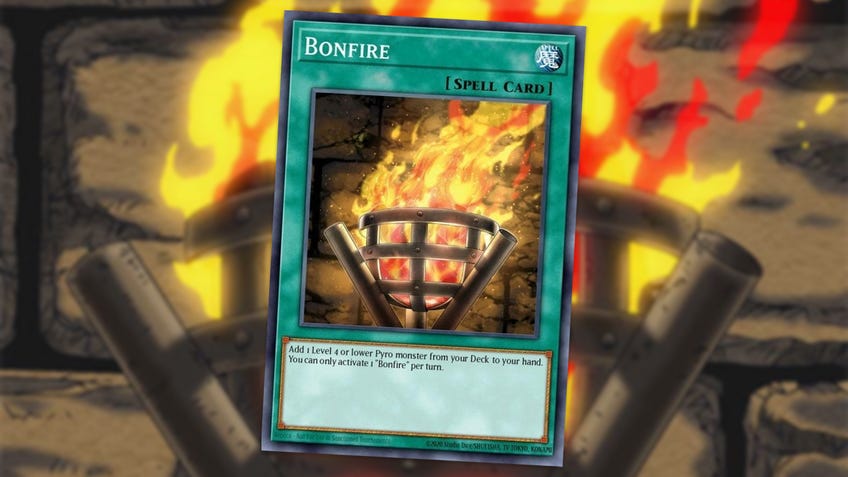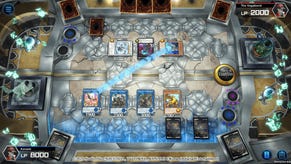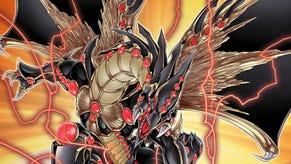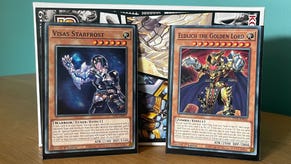Yu-Gi-Oh!’s Maze of Millennia set makes anime cards real for the first time in 25 years, without being relics
Thoughtful changes balance on-screen power with the modern meta.
It is only the second episode of the Yu-Gi-Oh! anime where Yugi Moto, fresh from his electrifying victory over Seto Kaiba, receives a strange video tape in the post. Putting it into his VCR, he’s sucked into a shadow realm duel against the creator of the card game itself, Maximillion Pegasus - a game where the failure to secure victory sees the creator steal the soul of Yugi’s grandfather. During this duel, there is one notable card used by Pegasus to shift the tide of the battle: Eye of Illusion.
Curiously mirroring the Millennium Eye item in his possession, Eye of Illusion allows Pegasus to take control of Yugi’s prized Dark Magician. It was the only appearance of the card in the entire series but, at such a crucial early moment in the series, it remained memorable to fans ever since - and yet, it never made an appearance in the real-world Yu-Gi-Oh! TCG. Until now, that is, as the card game’s latest set Maze of Millennia has brought Eye of Illusion and many more memorable cards from across the long history of the anime to life for the first time.
Eye of Illusion, while far from the only card to make its TCG debut in this set, is certainly one of the oldest, and remains so iconic as to adorn the artwork for the new set and inspire its name. Maze of Millennia is a set dedicated to answering one of the toughest questions surrounding the symbiotic relationship between anime and real-world card game fun: how do you translate anime effects geared towards exciting storylines into a fair, balanced card game?
Maze of Millennia answers a tough question: how do you translate anime effects into a fair, balanced card game?
Especially in the early series of the anime, it’s fair to say that the TV series had a somewhat loose definition of the rules. Returning to Duelist Kingdom, duel arenas gave creatures unique abilities based on their attributes that completely tore up the rulebook. Who can forget Yugi torching the field of Weevil Underwood to remove the woodland field from his bugs to secure victory, or Mako Tsunami hiding his sea creatures underwater to prevent attacks? Then you have the Seal of Orichalcos, the God Cards, Time Wizard… the list goes on. It wasn’t just the original series that was guilty of this, either. 5Ds also broke many rules - although at least justified its transgressions by taking the duels from the field to the racetrack.
These early cards were focused more on what made for an entertaining story, and the anime was more than happy to create new rules as it went along in order to justify itself. That makes things more difficult for the TCG’s team of designers at Konami to translate cards designed to break the rules and overpower opponents without considering what’s fair and what isn’t, and slot them into the balanced playing field of the real game. In many cases, they simply don’t - and when they do, changes have to be made.

This is one goal Konami has sought to achieve with the release of Maze of Millennia. Eye of Illusion is a perfect example. In the anime, it’s equipped to Pegasus’ Illusionist Faceless Mage and, after attacking Dark Magician, takes control of the creature the following standby phase. Despite being a weaker creature, it isn’t destroyed during the attack and Pegasus takes no damage. The full limits and use cases for the card are never fully explored, but this at least provides us with a framework for how it should theoretically function.
The final TCG card retains the spirit of the anime original without becoming overpowered. Instead of the Equip Spell it was before, it’s a Quick-Play card activated by controlling a Spellcaster or Illusion monster. After that, you activate one of the following effects:
- Your Illusion and Spellcaster monsters cannot be destroyed by battle this turn.
- During your opponent's turn: Target one face-up monster your opponent controls; take control of it until the End Phase.
- When an opponent's monster declares an attack: Target one face-up monster your opponent controls, except the attacking monster; change the attack target to it and perform damage calculation.
This approximates the immunity in battle and the ability to possess an opponent’s monster into an all-new card that retains the spirit. Better still, it’s hardly like the real card weakens Eye of Illusion to the point of existing solely as a relic or physical collectible. Provided you run a deck with a lot of Spellcaster monsters, it could be an interesting tech card to counter the overwhelming strength of an opponent’s board.

That’s not the only thing to consider. The time for the original Yu-Gi-Oh! anime has long since passed. Just because you can, doesn’t always mean you should. If you want to release these cards today, not only do you have to balance them to the rules of the game, you have to consider what, if any, use they’ll have in the TCG’s current metagame. Looking at the rest of the Maze of Millennia set, many of the included cards make thoughtful changes for balance while also considering whether there’s even a need for such a card to exist in the modern game.
Many of the cards make thoughtful changes for balance while also considering whether there’s even a need for such a card to exist in the modern game.
For Bonfire, which first made its appearance in Yu-Gi-Oh! GX, the use of the card is obvious; anything that can search out monsters from the deck is highly useful in terms of consistency. In the current metagame the ability to add any Level 4 or lower Pyro monster to your hand from the deck is hard to overlook in a deck like Volcanic or a teased TCG premiere Pyro archetype promised for the upcoming Phantom Nightmare. No wonder why it’s the most sought-after card in the new set for many fans.
Then you have Number 1: Infection Buzzking, the Zexel anime’s ‘ultimate’ number monster, with a rather powerful effect to boot. This card is a rare example of a monster which can interfere with the opponent’s Extra Deck, sending a monster from it to the Graveyard the moment it’s summoned, even before we talk about the destruction ability of its other effect.
The aim of Maze of Millennia is to bring classic anime cards to life and finally introduce those which have a chance to gain a competitive edge in the current metagame. It’s also a reminder of the fun the game can provide and that the anime sought to demonstrate, which seeps throughout the set.
One curiosity in the set demonstrates this more than any other: the introduction of an archetype inspired by Joey’s Flame Swordsman. The cards aren’t the most competitive, but for those who want to relive their memories of the anime without being entirely obliterated in battle, it gives you a fighting chance. Cards like Fighting Flame Swordsman, Fighting Flame Sword and Ultimate Flame Swordsman are an attempt to let the anime live on, with destruction and search effects that bring them up to speed with the modern game. If Joey were to duel today, this would be his deck.
The aim of translating anime favourites to the modern game is to make them playable, competitive and fair, but also to make them fun. Introducing these anime-exclusive cards while expanding upon them to fully realise them in the modern day. Whether we’re talking about the explosive search of Bonfire, Eye of Illusion or the myriad of other cards in the set, Maze of Millennia is an earnest experiment of translating intense storytelling into something fun, just as Yu-Gi-Oh! has done for the past 25 years.









